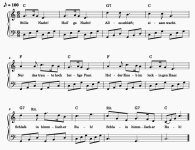Rosie C
Well-known member
Until today I didn't have any use for the counterbass button row on the Stradella, and being used to a 12-bass it just got in the way.
Today, a lightbulb came on! Our band has been booked for a Christmas show on 22nd December. I'll mostly be singing and playing 'guitar', I'll do a couple of numbers on accordion -probably the German carols - Silent Night, Tanenbaum and In Dulci Jubilo. I didn't think I could play this simple piano arrangement on accordion, but a few hours of the old subconscious brain working away, suddenly I remembered the counterbass row, and in fact this bass line is straightforward!
Hurrah!
Today, a lightbulb came on! Our band has been booked for a Christmas show on 22nd December. I'll mostly be singing and playing 'guitar', I'll do a couple of numbers on accordion -probably the German carols - Silent Night, Tanenbaum and In Dulci Jubilo. I didn't think I could play this simple piano arrangement on accordion, but a few hours of the old subconscious brain working away, suddenly I remembered the counterbass row, and in fact this bass line is straightforward!
Hurrah!

